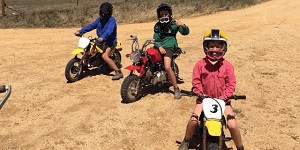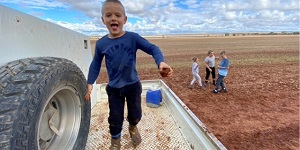No one likes starting an article this way, but it's an unfortunate truth that we hope to change. Kids who live on farms are more likely to be injured or killed than their parents or farm workers. Children are naturally curious, so it's important to keep them away from danger. This could be in the form of machinery and equipment, livestock or bodies of water. Keep in mind children under the age of 15 are more vulnerable to on-farm related accidents too. Whilst children learn about farm safety as they develop and grow, they also mimic the behavior of those around them. If you uphold the importance of best practice when it comes to safety, hopefully they will too. Don’t forget it's part of your duty to keep everyone on your farm safe.

Where to start
Addressing child safety on your farm can include the usual steps of a risk assessment. Talk to your workers, consult them about the day-to-day activity on-farm, they might have a different perspective of what poses a danger to children. Then identify the hazards, assess the risk and implement the controls to keep your children safe.
Where you can, engage your child’s curiosity and include them wherever you can on-farm. Lead by example – explain the dangers to them and create a culture of safety. It is important to always supervise your children and teach them to never leave the house or fenced play area without first asking an adult.
It is important to introduce out of bounds areas in and around silos, loading areas, dams, power tools and animal pens. Also consider introducing some family rules for when the kids are outside of the safe zone. This could include holding an adults’ hand, wearing safety vests or high vis colours, if children are in vehicles they always have a seatbelt on, etc. Children don’t always react to an unsafe situation in a predictable manner.
Be sure to remove hazards where you can too: lock workshops or sheds; keep electrical equipment and chemicals out of reach; cover tanks and ensure guards are fitted to ladders on silos, bins, windmills and tank stands; lock portable ladders away; pay particular attention when reversing vehicles and farm equipment; keep guns and ammunition locked away in a gun safe; always supervise children around livestock; and keep paddocks and animal pens locked. Children should know emergency procedures too – teach them emergency phone numbers and your property’s address.
As with adults, it is almost impossible to safety proof your farm, but being aware of hazards is an important factor. There are too many hazards on farm to cover them all in one article including drowning, guns, chemicals, falls from heights.
Machinery and child safety
Just like with adults, children riding in vehicles without a seatbelt could have catastrophic consequences. Whilst it might not look dangerous at the time, circumstances can change. Children should never ride in the back of utes, attachments or in tractors without restraints as there is always a real risk of rollover. Communicate expectations with workers, contractors and alike, that vehicle doors should always be left shut or locked with the keys removed.
For children old enough to be riding bikes, you should continually ensure they have a properly fitted helmet. Bikes (including motor bikes) will always note the suitable age of riders, detailing their age and height, it is best practice to stick to the manufacturer’s recommendations.
You should never allow a child under the age of 16 to ride or be passenger on a quad bike. Most children will lack the body weight, strength, and judgement to operate such machinery. When introducing your children to machinery and other farm vehicles it is important that they understand the dangers of speeding in addition to uneven terrain.
Traffic Management Plan
We hear you - what if your children are too young to understand the dangers of forklifts, tractors, trucks and telehandlers? This is where a well thought out Traffic Management Plan can help you communicate with others on your farm. Whilst the name seems a bit daunting, its easy to get started!
Think about how and where a person and a moving vehicle could collide, then draw a rough sketch of your property layout. Next it's time to think about the movement of that machinery or vehicle; will it be moving, reversing or changing direction regularly? Then its on to thinking about people moving around the machinery. What risk is there to them and how can it be reduced?

Signage, alarms and notifications are a great way to indicate a significant hazard. If you have reversing cameras on your equipment and an assigned spotter, it can make your operator aware of objects nearby. This is where the last step of traffic management comes into play for child safety, Visibility. Workers must be vigilant and stay in the operators’ line of sight, or at least be visible to the spotter who can alert the operator if there’s a potential problem (such as children).
Children are small and can move quickly and unexpectedly. A child could be under or near any vehicle in a matter of seconds so it is absolutely vital that operators slow down and take particular care when children are on farm.
To access your free farm safety checklist click here.
This article is courtesy of Safe Ag Systems



